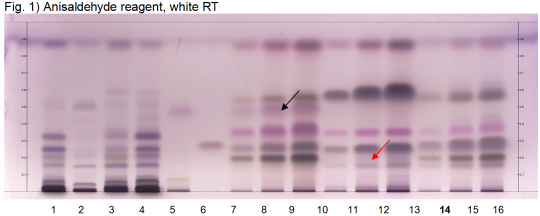Salvia lavandulifolia (leaf)
Contents |
Nomenclature
Botanical Voucher Specimen
Organoleptic Characteristics
Macroscopic Characteristics
Microscopic Characteristics
High Performance Thin Layer Chromatographic Identification
|
Spanish sage oil (leaf) (Salvia lavandulifolia) Lane Assignments Lanes, from left to right (Track, Volume, Sample):
Reference Sample(s) Reference: Dissolve 1 mg of thujon in 1 mL of toluene; Dissolve 30 µL of cineole in 10 mL of toluene. Stationary Phase Stationary phase, i.e. Silica gel 60, F254 Mobile Phase Dichloromethane Sample Preparation Method Sample: Mix 100 µL of sample with 10 mL of toluene. Derivatization reagent: Anisaldehyde reagent; Preparation: To 170 mL of ice-cooled methanol add 20 mL of acetic acid, 10 mL of sulfuric acid and 1 mL of anisaldehyde; Use: spray, heat at 100°C for 5 min. Detection Method Saturated chamber; developing distance 70 mm from lower edge; relative humidity 33% Other Notes Images presented in this entry are examples and are not intended to be used as basis for setting specifications for quality control purposes. System suitability test: Thujon: weak pink zone at Rf ~ 0.47; Cineole: violet zone at Rf ~ 0.27. Identification: Compare result with reference images. The fingerprint of the test solution is similar to that of the corresponding botanical reference sample. Additional weak zones may be present. The chromatogram of the test solution shows a dark grey zone at Rf ~ 0.54. At the position of reference cineole there is a diffuse violet zone (Rf ~ 0.27). Above it there is a pink zone (Rf ~ 0.34) and below the position of cineole there is an intense grey zone at Rf ~ 0.20. Test for other species: No zone is seen at the position of reference thujon at Rf ~ 0.47 (black arrow, Sage oil). The chromatogram of Clary sage oil lacks the grey zone at Rf ~ 0.20 (red arrow).
|
Supplementary Information
Sources
- ↑ HPTLC Association http://www.hptlc-association.org/
